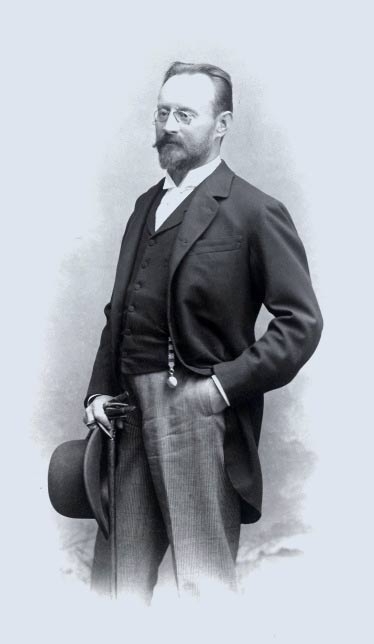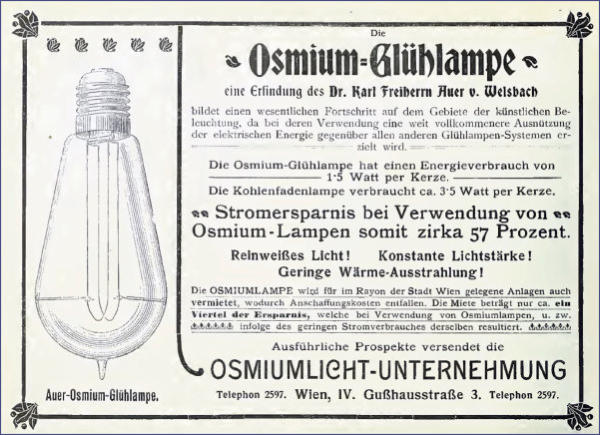125 years of metal filament lamps
Osmium as a light source - 125 years of metal filament lamps
By Günther Luxbacher
1898 marks a milestone in the history of the rare metal osmium. While there had been hardly any industrial applications for the metal until then, a fantastic boom in demand broke out in that year. This was because the chemist Auer von Welsbach had patented the concept for the first modern incandescent lamp: the osmium lamp!
In the aforementioned year 1804, the English natural scientist and businessman Smithson Tennant discovered two rare elements in his lavish private laboratory in London: Iridium and Osmium. He was able to extract these two substances from platinum, a material that he and his company partner William Hyde Wollaston had purchased in large quantities. From platinum, they manufactured chemical apparatus that could be sold at a great profit. At the same time, they also used their business to analyze platinum intensively. In this way, they killed two birds, science and business, with one stone.
However, at the time they found hardly any commercial uses for the new elements, soon to be called platinum by-elements. It took years before a few economically significant niches opened up. The most important was in the field of stationery. The text writers of the 18th century still used goose quill pens, red chalk pencils or pencils on paper - which at that time was still made of rags and handmade. Although the steel quill pen had been known since the middle of the 18th century, it was not until the early 19th century that it came into widespread use in England. However, since these did not have a particularly long life due to chemical (ink) and physical (pressure, bending, friction) stresses, some clever minds began to attach osmium splinters to the tips of the nibs. This was because it was already known at the time that osmium was extremely resistant and durable, both chemically and physically, due to its high density.
Until the end of the 19th century, only niche applications were found for osmium, as well as for the soon to be four other platinum by-metals. This remained the case until the end of the 19th century, when the then massively expanding electrical lighting technology suddenly catapulted osmium into the first rank of technically important metals.
In 1879, Thomas Alva Edison and the large team in his professional inventor's laboratory succeeded in developing a usable electric incandescent lamp. It is true that the German watchmaker and 1848 refugee Heinrich Goebel had already presented a lamp in New York that he had made himself, and which was proven in court. But given the lack of an electricity distribution system at the time, he had to make do with the modest electricity source of a galvanic element. Goebel's invention therefore sank into oblivion for several decades, from which the builder of an overall power supply concept Edison successfully brought it back again.
Today's eyes perceive the incandescent lamps of that time as a glowing orange dim that could hardly compete with the light of a kerosene lamp. This was because Edison used charred bamboo filaments, the manufacture and assembly of which he could just about manage technically. Physicists and chemists around the world were searching for a white-hot metal that could be processed into very fine filaments. Platinum was found to be suitable, but it was too expensive and so difficult to process that carbon filament was left for the time being. However, from the 1890s onward, the incandescent lamp industry used a process developed by the British chemist Joseph Swan. Instead of a fine carbonized bamboo filament, he used a filament consisting of a cellulose mass sprayed through fine nozzles and therefore very regular. It was then gently carbonized. This at least avoided the annoying irregularities of naturally grown bamboo, which had led to frequent thread breakage. The inventor of the osmium lamp then also relied on this concept of the sprayed thread. And this inventor came from gas lighting, of all things, which was competing with electric lighting and still dominating the market!

The Viennese chemist Carl Auer von Welsbach conducted research on the rare earth elements and other elements neighboring them in the periodic table, as he was firmly convinced of their potential as light sources. In 1885, the gas mantle was created in his Vienna laboratory as the most innovative lighting concept of the late 19th century. The gas mantle, a knitted textile hood impregnated with rare earth metals, significantly increased the light output of previous gas lighting during its annealing and ashing process.
Auer, who, like Tennant, was extraordinarily enterprising, associated himself with the German gas annealing company, which made huge sales worldwide with the Auer incandescent mantle. Before the First World War, about 300 million gas mantles were produced annually worldwide, and even around 1930, about 70% of the streets and about half of all Berlin households were illuminated with gas mantles.
Auer, who had thus become very wealthy, continued to research exotic metals for light generation in his private laboratory and realized that electric lighting perhaps had a greater future than gaslight after all. He therefore decided to invest all his energy in developing a brighter shining electric light bulb, which would undoubtedly have to be made of a metal filament.
However, since there were no precisely working thermocouples in the 19th century, it was not entirely certain which metal in the periodic table had the highest melting point and could therefore emit the brightest beam of light. The standard chemical manuals had settled on osmium as the metal with the highest melting point, so Auer focused on this element. Unfortunately, however, osmium was not workable with the methods of the time, precisely because it had such a high melting point and, on top of that, was extremely brittle. When hammered and bent, it broke immediately. The all-important question was how to make this metal usable for lighting purposes. Auer found an ingenious way to do this, and with it the basis of today's sinter metallurgy.
Auer used Swan's cellulose spraying process and mixed a small amount of finely ground osmium powder into the cellulose mass in his Vienna laboratory. In this way, he bypassed its mechanical processing. He patented this "paste process" in 1898, 125 years ago. He then injected this prepared mass through fine holes to form filaments, which he carbonized. The carbon filament, which was provided with ultra-fine osmium particles, was then mounted between two electrodes, the glass bell jar was evacuated, and then the power was switched on. Due to the resulting rapid increase in filament temperature, the osmium particles fritted together in the cellulose mass and the metal filament became white-hot conductive.
However, the sources suggest that Auer made an economic mistake after this ingenious technical move. He had his product, later called the "osmium lamp," "Auer lamp" and "Auer-Os lamp," manufactured and marketed again by the DGA, the German gas annealing company. Although this company was the market leader in the manufacture of incandescent mantles, it had no idea of how to produce electric incandescent lamps. Siemens, AEG and the young Dutch company Philips, on the other hand, had more than twenty years of experience in this field. They knew all the tricks of the manufacture of the carbon filament, its assembly with millimeter precision, cementing and clamping, the problems of passing the electrodes through glass, rapid evacuation, and so on. The DGA underestimated this hi-tech knowledge in production at the time and needed years to acquire it - for example, by poaching experts. This was to take its toll.

Another problem was that the known worldwide supply of osmium at the time was between a hundred and a few hundred kilograms. Auer and the DGA had secured close to 100 kilograms of the rarest metal. But competitors spread rumors that there was too little osmium to satisfy the world's demand for metal filament lamps. In addition to the production problems, this further contributed to the fluctuating price of DGA shares.
Despite all these downsides, everyone was excited at the sight of the new light source. It did not blind like the large outdoor illuminations of electric arc lamps that lit up the night squares and boulevards. And yet it provided brighter, pure white, and also better light than the previous candles, kerosene lamps, carbon filament lamps, or gas mantles. These suddenly appeared to be very dim, and the general public could now perceive how strongly their color spectra tended toward the reddish and greenish. Women suddenly worried about their teint under gaslight, for example. In addition, the new incandescent lamp was used as a pixel for large-scale rasterized fields on building facades, on which small cartoon sequences were shown that advertised pickles, beer or nightclubs. Around 1910, New York's Broadway looked in places like a preparatory study for the sets in the science fiction film classic "Blade Runner". Even in Berlin, salamanders and champagne bubbles were now climbing up nightly building walls - even when sober.
Unfortunately, the DGA did not get a grip on its mass production problems until around 1903/04. It was looking back on a largely lost five or six years. And to make matters worse, it turned out that there was not to be a second chance. Not because osmium was in short supply, but because temperature measurement technology, chemistry, sintering and metalworking technology were making huge advances. It soon became clear that tungsten, not osmium, was the highest melting metal. Under the name "Osram" lamp (a combination of osmium and the German word for tungsten, "Wolfram"), which blurred the previous misconception, the DGA finally launched a tungsten filament lamp in which tungsten powder was used instead of osmium powder. However, the research departments of the traditional incandescent lamp manufacturers in the US and Europe had not been asleep either and had tried to make the brittle metals ductile, i.e. drawable through a hol. In 1906, Siemens produced the first metal wire lamp, albeit using only tantalum, a metal that was only moderately suitable for this purpose. In 1911, a consortium of General Electric and European manufacturers finally brought the tungsten wire lamp onto the market. The General Electric research laboratory had finally succeeded in making tungsten, which was brittle like osmium, ductile. This meant the end for the less efficient osmium and tungsten filament lamps.
As a result, the DGA was left sitting on a pallet of vessels filled to the brim with osmium powder at its headquarters in Berlin. Instead of too little, they now had too much and were desperately looking for a buyer. After the First World War, the company managed to save itself in the big corporate merger called Osram GmbH KG. As a result, the first two letters of the rarest metal in the world have been preserved, at least in the famous company name, to this day.
Photo credit: https://de.wikipedia.org/wiki/Carl_Auer_von_Welsbach, www.streetlight-hamburg.de/zeittafel_13.htm



Osmium-Institut zur Inverkehrbringung und Zertifizierung von Osmium GmbH
Kemmelallee 682418 Murnau am Staffelsee
Germany


 UM
UM